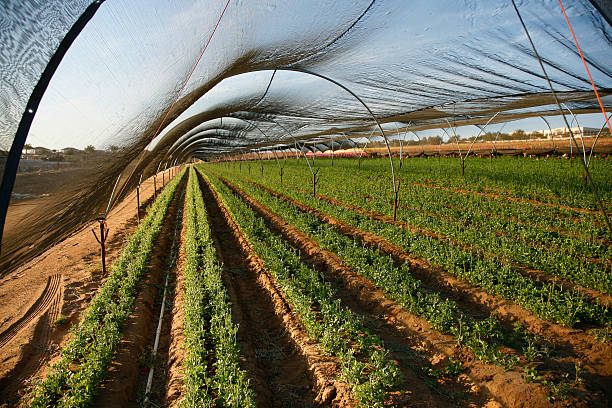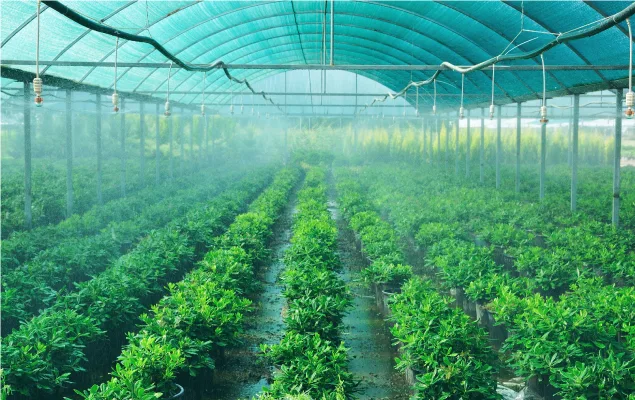Agriculture Shade Nets for Crop Growth and Protection
Agriculture shade nets are beneficial for crop growth and production by providing protection from excessive sunlight, reducing the stress of temperature, and minimizing the use of water.
In this blog, we will discuss the advantages and applications of agricultural shade nets in detail to better understand their use in crop protection and production.
What are shade nets?
Shade nets are particularly designed fabrics made from high-density polyethylene (HDPE) that provide shade, and UV protection, draw boundaries, and serve more purposes in various industries, including agriculture, commercial, and construction.
What are agriculture shade nets?
Agriculture shade net, also known as ‘agro-shade nets’, are one of the major tools in modern farming and are used to ensure the safety of crops and plants. Additionally, they can be easily customized due to the wide options of colors, densities, and sizes.
They are made from woven or knitted fabrics that are 100% high-density polyethylene (HDPE), which protects the crops and allows the growth of plants by absorbing heat, UV rays, and water evaporation, and providing the soil with moisture.
Advantages of agricultural shade nets:
Agriculture shade nets offer a wide range of advantages that contribute to the growth and development of crops. Let’s discuss these advantages in detail:
- Control of temperature: High temperatures can be harmful to crops and lead to losses in production. By installing shade nets, farmers can prevent heat stress from sunlight on plants as the heat-absorbing material of shade nets absorbs the varying intensity of the sun’s rays throughout the day, stabilizing the overall temperature inside.
- Protection from UV rays: UV rays are harmful to plants because they reduce photosynthesis and damage the plants. Agricultural shade nets provide a layer of protection against UV rays; hence, they are also known as UV stabilizers.
- Combat Pest Management: Shade nets act as a physical barrier to prevent harmful insects and pests from entering the fields. Also, a few colored shade nets make it more difficult for the insects to enter the area, which will decrease the chances of crop distortion.
- Reduction in water usage: Shade nets regulate temperature and humidity by reducing evaporation and optimizing water consumption. By using shade nets, farmers can save significant amounts of water, which makes them an ideal tool for water reservation and effective irrigation practices.
- Plant preservation: In addition to temperature control and pest control, agricultural shade nets also help to protect the plants from wind damage and soil erosion. It acts like a windbreak, protecting topsoil and sensitive plants from strong winds, resulting in healthier plants and increased production.
- Chemical-free farming: Demand for natural products is increasing nowadays, and shade nets help reduce the use of chemical pesticides and fertilizer by protecting crops from insects and harsh climate conditions, resulting in healthier and more ecological farming.
Overall, agricultural shade plays a crucial role in ensuring crop health and productivity.
Applications of the agriculture shade net:
Agriculture shade nets have a wide variety of uses, and they act in a versatile manner to provide protection and the required shade to the plants.
Some of the applications and core areas are mentioned below where shade nets are highly recommended:
- Shading factor: Agriculture shade nets are manufactured from high-density polyethylene (HDPE), which provides 75% of the shading, and the remaining 25% serves as the visibility hindrance. These shades give out the proper amount of shading and sunlight required for the photosynthesis process of the plants, which helps in the growth and development of crops.
- Drawing Fences and Boundaries: A shade net fence is a sort of protective barrier; it is referred to as shade cloth fencing or windbreak net fencing. It is frequently utilized to offer shade and wind protection in agriculture, as well as to keep animals out of the area.
- Crop Segregation: These shade nets also play a vital role in making the segregation, which assists in practicing mixed farming and putting sections in fields, which ensures land management and easy cultivation.
- Crop Management: By means of shade nets, crops get sufficient protection and coverage, which helps the crops grow. The shade nets provide protection from UV radiation, excessive heat, and other harsh climatic conditions, which is greatly advantageous for both the quantity and quality of plants.
- Temperature Regulation: Crop damage and productivity loss can result from high temperatures. Farmers may control temperatures and avoid heat stress from sunshine on plants by constructing shade nets. These shade nets absorb the excess heat of the sun and maintain a good environment for the crops and plants.
- Pest Control: Shade nets serve as a physical barrier to keep dangerous insects and pests out of the fields where the crops are grown.
Which shade net is best for agricultural activities?
The agriculture shade net stands out as the most reliable option for agricultural purposes. From combating pests to temperature regulation and UV resistance, they are all-rounded to grow crops and plants in a systematic manner with a lifespan of up to 8 years.
On top of that, it is more cost-effective in comparison to options like Green Shade Net, which costs less but demands reinstallation every 3–4 years. That’s why they are better suited for shorter-term projects like construction and outdoor events.
Conclusion:
In conclusion, agriculture shade nets play a vital role in modern farming techniques by serving factors like UV protection, providing moderate temperature conditions, and reducing heat stress, which helps in healthy and productive farming.
With their customizable options and durability, agriculture shade nets are an essential tool for farming. These nets offer numerous benefits that enhance crop growth and overall agricultural productivity.









